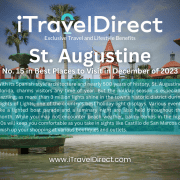Quebec City #11 in Best Places to Visit in December of 2023
Why Go To Quebec City
It’s easy to fall in love with this Canadian destination, especially when it’s covered in fresh snow. You’ll be enchanted by Old Québec’s sights and sounds as it transforms into a Christmas village. Or, you can shop for gifts (or for yourself) in Quartier Petit-Champlain. Plus, with its 17th- and 18th-century architecture, Quebec City allows you to soak up European culture without dropping the cash for a flight across the pond. Just be sure to bundle up. Temperatures can drop to below-freezing in December.
The sight of winding cobblestone streets and towering cathedrals; the sound of French pleasantries and tourists’ “Oohs;” the smell of fresh-baked bread and pungent cheese; the taste of creamy cafe lattes and buttery croissants. All your senses agree: You’re in France. But they’re wrong: You’re in Québec.
Québec City – the capital of the Canadian province, Québec – dwelled in the shadow of its neighbor, Montréal, for a long time, but the 2008 celebration of its 400th birthday catapulted Québec City back into the spotlight. Since then, travelers have flocked here to experience this UNESCO World Heritage Site’s charm for themselves. Upon passing through the fortified walls of Old Québec, you’ll discover a world straight out of a European painting: 18th- and 19th-century buildings house bakers, bistros, and boutiques, while cobbled squares are drowned by a sea of cafe tables. And around every corner, a piece of Québec City’s rich heritage awaits discovery.
Best Months to Visit
The best times to visit Québec City are June through September and December through February. During the summer and winter months, the city’s social calendar is booked solid with festivals. Summertime is the most popular time to visit due to the warmer weather, but the Québécois relish winter’s icy winds, protecting themselves from the cold weather with hefty parkas and plenty of coffee from a local cafe. The spring and fall shoulder seasons see fewer tourists because of the lack of special events, but that means travelers can take advantage of low rates as well as seasonal perks: Springtime is maple syrup season, while autumn dazzles with colorful foliage.
Culture & Customs
The best times to visit Québec City are June through September and December through February. During the summer and winter months, the city’s social calendar is booked solid with festivals. Summertime is the most popular time to visit due to the warmer weather, but the Québécois relish winter’s icy winds, protecting themselves from the cold weather with hefty parkas and plenty of coffee from a local cafe. The spring and fall shoulder seasons see fewer tourists because of the lack of special events, but that means travelers can take advantage of low rates as well as seasonal perks: Springtime is maple syrup season, while autumn dazzles with colorful foliage.
What to Eat
Québec City’s cuisine has strong French ties, which can be found in its hearty stews, meat pies, specialty chocolate shops, bakeries, crêperies and cafes that fill the streets. A popular dish to try is poutine: French fries smothered in fresh cheese curds and topped with a hot gravy.
For a distinctly Canadian meal, head to La Traite; the restaurant’s menu features ingredients that have been locally caught or picked. Located in a building that dates back to 1677, Aux Anciens Canadiens’ waiters don period-style clothing and serve authentic dishes that feature locally produced maple syrup. Le Clocher Penché’s weekend brunches are also popular for visitors and locals alike.
Getting Around Quebec City
The best way to get around Québec City is on foot. Once you pass through the walls of Old Québec, nearly everything you wish to see or do is within walking distance. But if your feet grow weary or the weather is just too chilly, the city’s Métrobus shuttles visitors around the historic area with three different routes (1, 11 and 25). And for excellent views, consider a ride on the funicular, a steeply sloping railway connecting Haute-Ville (Upper Town) and Basse-Ville (Lower Town). You do not need a car in Québec City, but if you plan on taking a day trip or two, you can rent a car in town or at the Jean Lesage International Airport (YQB), located about 8 miles west of Old Québec. Another option for exploring is by bike. A series of bike paths start from the Old Port area and travel along the river and out to the suburbs.
On Foot
Because many of Québec City’s top attractions can be found within Old Québec’s ancient walls, you won’t need more than your own two feet to make the most of your visit. Just make sure that you’re dressed warmly, especially during the winter months, and that you stop frequently: The city’s many cozy cafes and quaint shops make excellent venues to thaw.
Bike
If you want to see more of the river or take a look at what the suburbs of Québec City look like, there are several excellent inline bike trails, most of which start in the Old Port. The 5 ½-mile Corridor de la Rivière-Saint-Charles trail starts from the Jardins du bassin Louise, is separated from traffic and loops along both banks of the river. Other routes can be found on the Quebec City Tourism website. There are a couple of area companies that rent bikes and offer guided tours. However, considering the hills in Old Québec, biking is not the best way to get around the city.
Bus
When you grow tired of walking or the cold weather has chilled you to the bone, Québec City’s RTC (or Réseau de Transport de la Capitale) Métrobus is there to save the day. There are three bus routes that offer transport throughout Old Québec, stopping near many of the neighborhood’s most popular attractions, such as the Citadel and the Museum of Civilization. A one-ride general ticket costs only CA$3.40 (about $2.50), or CA$3.75 (about $2.79) if you pay in cash. Discounted fares are available for children, teens, students and seniors. One-day passes, unlimited weekend passes and five-day passes (Monday through Friday) are also available. Buses stop every 10 to 15 minutes, so visitors won’t have to wait long to catch a ride.
If you’re exploring outside the old city walls, there are 55 leBus routes to help you explore. RTC operates 60 bus routes throughout the greater metropolitan area, but to figure out which buses to rely on for all your tourist needs, check out RTC’s handy bus guide for visitors. Fares are the same for Métrobus as they are for the leBus.
Funiculaire
It’s a pretty steep climb from Old Québec’s Basse-Ville (Lower Town) to Haute-Ville (Upper Ville). To save your energy and to enjoy fantastic views, ride the funiculaire. This cliff-side elevator travels 210 feet at a 45-degree angle between the northern edge of the Quartier Petit-Champlain in Basse-Ville to Dufferin Terrace, near the entrance of the Château Frontenac in Haute-Ville. The funiculaire opens every day starting at 9 a.m. and closes at 10:30 p.m. in summer; closing times vary the rest of the year. Rides cost CA$5 (about $3.75) per person.
Taxi
Taxis are plentiful in Québec City. While you can hail them on the street, you may have better luck catching one if you download the Taxi Coop smartphone app and order one, or look for a designated cab stand. The meter starts at around CA$4.10 (roughly $3.05), and each extra kilometer (approximately 0.6 miles) costs CA$2.05 (about $1.55). The ride-hailing app Uber also operates in Quebec City.
Car
You can rent a car either in town or at the airport, but we strongly advise you not to. Parking on Old Québec’s narrow streets can be a nightmare, not to mention that you’ll be hard-pressed to find a free spot (even in the evenings and on weekends). Plus, Canadian gas prices closely resemble America’s, except you’ll be charged by the liter rather than by the gallon, making it more expensive. The only time a car would come in handy is when you’re taking a day trip outside the city (to Jacques-Cartier National Park, for instance). If that’s the case, we suggest waiting to rent until the day of.
Remember: Distances and speeds are posted in kilometers per hour and some signs may only be in French. U.S. driver’s licenses are valid for visitors in Canada.
Start Saving with iTravelDirect’s Exclusive Travel and Lifestyle Benefits Membership
CLICK HERE to Test-Drive our Guaranteed Savings
We offer a 110% Price Guarantee – Find a lower price anywhere online and we will refund you 110% of the difference.
CLICK HERE for a full list of services and Membership Discounts.
When you join iTravelDirect, you’ll have full access to all club benefits.
Your membership gives you the freedom to travel when you want, to where you want.
And you won’t find lower rates anywhere, guaranteed. So, pack your bags and start planning that vacation of a lifetime today!










